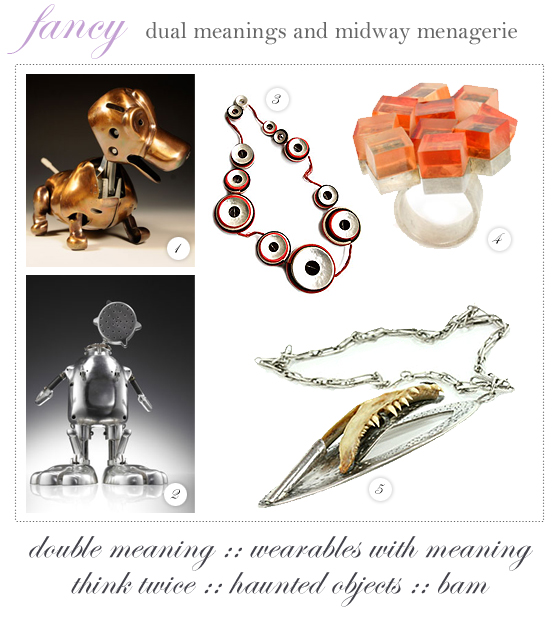
It had been too long since this Bird wandered the halls of the Bellevue Arts Museum. Renewing my membership for the year was a good reminder to take a break from a nonstop work schedule and take some time for thoughtful observation. Aside from taking in some really beautiful new exhibits, it was a good refresher to one's own creative process that one must always be taking in other people's art, ensuring the work we produce remains informed.
The latest exhibits that caught this Birdy's Fancy are the Think Twice: New Latin American Jewelry and Cathy McClure: Midway. They're both exceptionally different collections, but they have a theme of objects and meaning; how everyday things, whether ornamental or mundane, can suddenly become striking when put in a new context. Maybe that's just a "well, duh" observation of art as a whole, but I really appreciated the Latin American jewelry exhibit that showed some truly beautiful wearable art that was infused with strong stories and emotion. Pieces that encased photo negatives in resin, multiplied many times and applied to a ring or a pin, implying a sense of time captured and then made sacred. There's a plantain covered in platinum and made into a necklace; a gaudy piece meant to point out the absurdity of ostentatious status jewelry but also a sense of cultural loss, as the organic plantain is meant to rot within its precious metal cage, while the physical ghost of the object remains. I liked this collection as it forces you to really investigate each piece, given their small size; you have to go up close and examine it from all angles, as several pieces have hidden visuals that you'll miss if you don't really explore it. The materials are all chosen with poignance and intent, keeping the line between artistic statement and aesthetic wearable blurry and thoughtfully obscured.
The new Cathy McClure Midway installation is a more environmental experience. There are standalone pieces of ticky-tack toy-like animals that greet you with an expectation of off-kilter whimsy, but when you enter the full exhibit, you're surrounded by eerily macabre sounds, objects and moments of light and dark; you're no longer in the museum, you're stepping into the artist's mind. Installation pieces that really envelop the viewer can sometimes be difficult for people to appreciate; it's a little off-putting to go from being the observer, looking at objects on a wall or encased in glass, and then feel like you're literally walking into the nexus of an art piece, where every part of the space is used and there is no safety of a protective glass case or the obvious outline of a frame to separate one from the art. It's the observer that becomes the alien element, and there's an unnerving feeling associated with that. But I think that's where art becomes really visceral and real, a reminder that it should go beyond the typical "Oh, that's a nice painting," and something more interactive and modern, requesting the viewer to become immersed in the work. McClure's Midway pieces are a Tim Burton-esque lullaby to childhood and memories that inevitably become tinged with time and adulthood. The objects themselves are cheery and whimsical, with patchwork robots and animals built with familiar utensils and appliance parts, but when displayed in an installation that has shadowy lights, a silent film looping of one of her creations hopping around, and an impressive mini carousel that dances in the periodic burst of strobe lights, the exhibit takes on a larger story of childhood treasures in a state of decay and worry. The carousel spins with its Steampunk-ish figures and creatures in Eadweard Muybridge-like duplications of incremental motion, so that when the strobe hits them, the eye reads it as fluid motion and they cast a haunting shadow around the white walls.
These exhibits are very different, but they will absolutely leave one feeling alive and inspired in different ways, as both observer and participant in the artist's message. There is no right or wrong answer when enjoying art; it's a very human thing to overlay one's own experiences with a piece, even if it doesn't exactly match the artist's intent -- I think that's by design. An artist can't be so full of hubris to expect every viewer to take away the same reaction they had when creating the piece; art is communal and I think creatives understand that one should take away their own personal interaction with a piece, as that's where art ceases to merely be an object, but a soulful connection.
Jaunty Fine Print: photos from the Bellevue Arts Museum; work by {1, 2} Cathy Mc Clure, {4} Claudia Cucchi, {5}Renny Golcman, {3} Linda Sanchez




No comments:
Post a Comment
Merci buttercups! Your comments are appreciated! (hit the 'post comment' button twice, sometimes it's buggy)